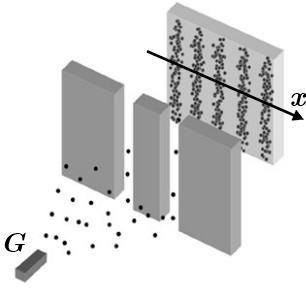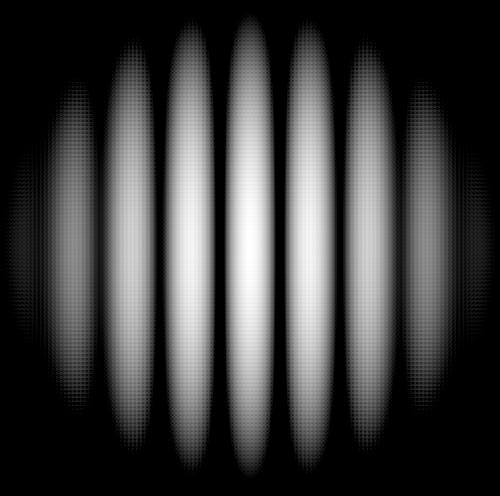The Double Slit Experiment
by Andrew Boyd
Today, a mysterious experiment. The University of Houston's College of Engineering presents this series about the machines that make our civilization run, and the people whose ingenuity created them.
Physicist Richard Feynman was fond of saying that the mysteries of quantum mechanics could be understood from one experiment. It's called the double slit experiment. The results leave us in awe. But the experiment is simple.
Imagine I take a baseball and dust it with a little chalk, so when I throw it at a wall, it leaves a white mark. Suppose I place a giant metal plate between me and the wall. I cut a slit in the plate wide enough for well thrown balls to get through, and I start throwing. My aim's not very good, so many of my throws bounce off the metal plate. But those that get through the slit will form a pattern of chalk marks on the wall, and they'll look a lot like the shape of the slit. It's like putting a giant metal stencil in front of the wall, and spray painting with chalk-covered baseballs. If I put two slits in the plate, I wind up with chalk marks of two slits.
Nothing very exciting so far. But let's try this same experiment on a smaller scale with electrons. Electrons are particles, with mass just like baseballs. When I throw them at a single slit, they act just like the baseballs and make a pattern that looks like the slit. But if I throw them at two slits situated next to one another, something very strange happens. They no longer show up just behind the slits. They show up everywhere, making complex wave patterns. Well behaved particles just can't do that.


Image: Timm Weitkamp
To investigate further, we might try watching how the electrons got to the wall, not just where they hit. That's harder than watching baseballs, so we'll set up a camera at the metal plate. We won't see an electron's whole trip to the wall, but at least we can watch which slit each electron goes through.
This experiment works just fine. Electrons are thrown, and we see them hit the metal plate or pass through exactly one of the slits. But here's the really weird part. When I watch them, they no longer show up all over the place on the wall. They show up only behind the slits, just like we'd expect them to. It appears that the very act of watching the electrons changes the outcome of the experiment!
If this seems too strange to comprehend, it is. The experiment is easy enough to understand and repeat, and there's good mathematics describing what happens. But an actual interpretation plunges physicists into the world of metaphysics. Niels Bohr believed the observer really did create reality. Stephen Hawking turns to an infinite number of parallel universes for an explanation. But the wonder of the experiment is that it takes us to the precipice of human understanding. The math may seem daunting, but the experiment and the questions it raises are open to anyone willing to ponder them.
I'm Andy Boyd at the University of Houston, where we're interested in the way inventive minds work.
Notes and references:
The double slit experiment, in various forms, is one of the most famous experiments in physics. As such, a wealth of information can be found on the Web. See, for example, http://physics.about.com/od/lightoptics/a/doubleslit.htm.
The pictures are from Wikimedia Commons. The image on the right, https://commons.wikimedia.org/wiki/File:Double_slit_x-ray_simulation_0600mm_log-grayscale.jpg, was created by Timm Weitkamp.